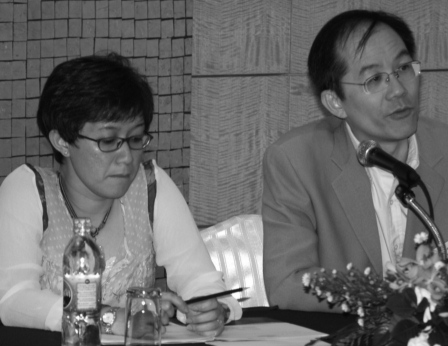Treatment Scale-Up: A Looming Crisis?
TAHOD Paper Underlines Key Problems Facing Real-World Drug Treatment
By Jeffrey Laurence, M.D.
July 2007—One of the primary goals in the global fight against HIV/AIDS has been to dramatically ramp up the number of HIV-positive people receiving combination anti-HIV therapies. But there are key problems with these plans that could have devastating effects over the long term unless addressed now—problems illustrated in a recently published paper from the TREAT Asia HIV Observational Database (TAHOD).

Drs. Adeeba Kamarulzaman and Patrick Li, chair and co-chair respectively of the TREAT Asia Steering Committee, were two of the authors of a recently published TAHOD paper exploring the challenges of drug treatment. |
For the recent study, which appeared in the January 2007 issue of HIV Medicine, TAHOD researchers gathered information on patients taking the most popular combination of anti-HIV drugs currently in use in Asia, d4T/3TC/NVP (stavudine, lamivudine, and nevirapine). These generic medications are common because they are relatively inexpensive and come in a convenient fixed-dose form. But they also have many disadvantages. And knowledge as to how well they are tolerated and maintained in the real world of everyday patient care in resource-poor settings is essential to predicting the success of large-scale AIDS treatment programs.
Indeed, almost one-third of the patients surveyed stopped taking the d4T and 3TC, most within a year. Side effects were the major reason for dropping out, the top two being lipodystrophy—the often disfiguring changes in body fat known to be a key problem with d4T—and liver disease. Even more discouraging was the fact that after stopping their first HIV treatment regimen, two in five patients failed to turn to any new HIV therapy.
While anti-HIV drugs do work—the vast majority of patients changing or stopping treatment in the TREAT Asia study did so because of drug side effects, not clinical failure—the lack of alternative treatments for many of these patients suggests that the emergence and evolution of drug-resistant strains will grow and that life-prolonging effects of treatment will be denied. Attempts at a “one-combination-fits-all policy is potentially going to deprive a substantial number of patients of effective long-term therapy,” the HIV Medicine report concluded.
Twelve years ago, when combination treatments for HIV were first introduced, many argued that a lack of sophisticated health infrastructures and the inability to test for T-cell counts and viral loads would preclude effective therapy in resource-poor areas. Findings from TAHOD and other surveys show that such limitations do not necessarily impede the use of potent anti-HIV drugs. But, as the report highlighted, more potent alternative drugs with fewer side effects—drugs that are now readily available in wealthy nations—are needed in Asia and throughout the world with increasing urgency.
Dr. Laurence is senior scientific consultant for amfAR.